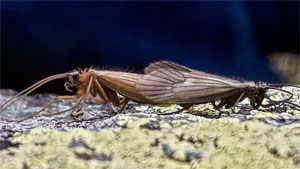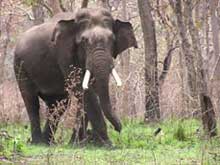April 2021 Environment
Sakshi Education
- New species of insect discovered in Kosovo is named after coronavirus
 A recently discovered insect has been named after coronavirus with lockdown rules helping a biologist complete his work.
A recently discovered insect has been named after coronavirus with lockdown rules helping a biologist complete his work.
Professor HalilIbrahimi had spent years working on a research report on a caddisfly species found in Kosovo's western Bjeshket e Nemuna (Accursed Mountains) national park.
The species has now been called Potamophylax coronavirus.
As an associate professor of the Natural Sciences Faculty at Pristina University, Prof Ibrahimi collected the species, which turned out to be endemic to the national park, 75 miles (120km) west of the capital Pristina, and found it was quite different from the other species in the Balkans.
It is considerably smaller, and lives in a different habitat, in open, high-altitude zones, some 2,000 metres (6,500ft) above sea level.
During his research, he also noticed that the LumbardhiiDecanit River, where the new species was found, has severely deteriorated over recent years due to the construction of a hydropower plant.
- Harsh Vardhan inaugurates 'green crematoria' to mitigate air pollution
 According to the Minister of Science & Technology, Earth Sciences and Health & Family Welfare, exceedingly high concentration of air emissions with respect to particulate matter, and other harmful gases have been measured in regions around the crematoria.
According to the Minister of Science & Technology, Earth Sciences and Health & Family Welfare, exceedingly high concentration of air emissions with respect to particulate matter, and other harmful gases have been measured in regions around the crematoria.
To address the high localized toxic emissions from crematoria, CSIR-National Environmental Engineering Research Institute (NEERI) has developed a technology knowhow to mitigate air pollution from Open Pyre Green Crematoria’s.
He inaugurated four pyres of the Green Crematoria at Delhi’s Nigam Bodh Ghat Crematorium here. He also inaugurated three new pyres run by Indraprastha Gas Limited.
- A third of global greenhouse gas emissions from food production
The study by a group of researchers in Italy published recently in the journal Nature Food draws on a new global database that provides estimates of food system greenhouse gas emissions from 1990 to 2015.
One third of global greenhouse gas emissions caused by humans are linked to food.
The figure is higher for developing countries but also declining significantly in step with decreasing deforestation and increasing downstream activities such as food processing and refrigeration.
The Emissions Database for Global Atmospheric Research (EDGAR)-Food by the European Commission categorised emissions data by sector, greenhouse gas and country.
It incorporated key land-use data for over 245 countries that has been compiled by the United Nation’s Food and Agriculture Organization (FAO).
Overall, the study found that food-system emissions represented 34 per cent of the total greenhouse gas output in 2015.
Land-use change and agricultural production to packaging, fertilizer use and waste all contribute to the emissions and were estimated at 18 billion tonnes of carbon dioxide equivalent in 2015 (34 per cent).
The emissions are down from 44 per cent in 1990, indicating a gradual decline even as food systems emissions kept increasing.
Share of emissions from the food system of a country ranged between 14 per cent and 92 per cent. In industrialised countries, roughly 24 per cent of total emissions came from their food systems, a number that has stayed fairly stable between 1990 and 2015, according to the study.
Asia was the highest contributor producing 35 per cent of global food system emissions in 1990 and 49 per cent in 2015.
The various stages of food production, which include inputs such as fertilizers, were the leading contributor to overall food-system emissions, constituting 39 per cent of the total.
Land use accounted for 38 per cent and distribution contributed 29 per cent, which is expected to continue growing.
Methane from livestock raising and rice cultivation accounted for 35 per cent of food system greenhouse gas emissions and is broadly the same in both developed and developing countries.
The research highlighted how global food systems are becoming more energy intensive, reflecting trends in the retail, packaging, transport and processing sectors, whose emissions are growing rapidly in some developing countries.
Globally, refrigeration was estimated to be responsible for 43 per cent of energy consumption by the retail and supermarket sector.
The data suggest that GHG emissions from the retail sector increased by 4.2 and 3.6 times in Europe and the United States, respectively, between 1990 and 2015.
An increase in the market share of supermarkets in the food distribution sector has been observed in all continents, including Africa, Asia and South America.
Cold chain activities around the world accounted for around 5 per cent of food-system emissions. It is expected to increase.
Packaging also contributed about 5.4 per cent of global food-system emissions, which was more than transportation or other supply-chain factors.
However, intensity of emissions varied notably with product. Wine and beer accounted for a significant share of packaging emissions while bananas and beet sugar had higher transportation emissions.
According to a report published in the journal Science, researchers found that greenhouse gas emissions from food production alone would cause 1.5 degree Celsius (°C) global warming by 2050 and 2°C by the end of the century.
Database will assist towards developing effective mitigation and transformational pathways to sustainable food systems.
There is a need for policies to improve efficiency, reduce emissions in the supply chain, and enable people to access healthier diets.
It will also provide greater understanding and estimate of the climate effects of food production, distribution and consumption, ahead of the landmark UN Food Systems Summit later this year.
The summit will launch bold new actions to deliver progress on all 17 of UN’s sustainable development goals, each of which relies to some degree on healthier, more sustainable and equitable food systems.
- Environmentalists, residents against legalisation of mining in Aravalis
Ahead of the hearing of a petition by Haryana government seeking permission for mining in Aravalis in Gurugram and Faridabad in the Supreme Court, environmentalists and the residents are strongly opposed to mining being legalised and demand that forest cover be increased in the State.
In an email campaign to the Chief Justice of India, the residents have been demanding that no mining and real estate be allowed in the Aravalis.
Instead, the government should come out with a three-year roadmap to take the legal native forest cover in the State to 20%, as per the Haryana Forest Department policy target and an all-India average.
The other demands include demolition of all illegal construction in the Aravalis, planting of native sablings, notifying 50,000 acre of the Aravalis as deemed forest and retaining the Aravalis in South Haryana as Natural Conservation Zone.
The residents, in the email, argued that destruction of the Aravalis would worsen the air pollution situation in the NCR and the mountain range is the only natural barrier against desertification.
The Aravalis, with their natural cracks and fissures, have the potential to put two million litres of water per hectare in the ground every year.
Besides, the mountain range is a biodiversity hotspot with 400-odd species of native trees, shrubs and herbs; 200-odd native and migratory bird species;100-odd butterfly species; 20-odd reptile species and 20-odd mammal species, including leopards, says the email.
As per the Economic Survey of Haryana 2020-21, as many as 58 mines out of the total 119 have been allocated.
More than 26,000 cases of illegal mining, including 1,358 till September 2020 for the current financial year, have been reported.
Besides, the collection from mining for 2020-21, till January, is Rs.770.00 crore – the highest since 2005-06.
- African elephant species now Endangered and Critically Endangered - IUCN Red List
 The International Union for Conservation of Nature (IUCN) declared African Forest elephants and Savanna (or jungle) elephants to be "critically endangered" and "endangered".
The International Union for Conservation of Nature (IUCN) declared African Forest elephants and Savanna (or jungle) elephants to be "critically endangered" and "endangered".
African elephants were considered a single species and were classified as "Vulnerable." This is the first time that these two species have been individually assessed by the IUCN Red List.
The African elephant is the largest terrestrial animal on earth and they are slightly larger than Asian elephants.
They have two finger-like features at the ends of their trunks, while Asian elephants have only one.
Elephants are matriarchal, which means they live in female-dominated groups. African elephants are a key species, which means they play a vital role in their ecosystems. Elephants are also known as "ecosystem engineers" and can shape their habitat in many ways.
The elephant's pregnancy time is nearly 22 months longer than that of any other mammal Since there are not enough calves to make up for the losses caused by poaching, the problem of protection is increased.
There are two subspecies of African elephants: Savanna elephants (or jungle elephants) and Forest elephants.
- Tigress Sundari back in Madhya Pradesh as translocation project fails
Tigress Sundari was moved back to Congress. This was mainly due to strong protests from villagers living on the edge of the reserve.
India’s first interstate tiger migration project was launched in 2018. Two big cats, a male cat (Mahavir) from Kanha Tiger Reserve and a female cat (Sundari) from Bandhavgarh in Madhya Pradesh were moved to Satkosia Tiger in Odisha Reserve to support the tiger population in the state.
The purpose of relocation is for two purposes: 1) Reduce the number of tigers in areas where there are too many tigers to drastically reduce territorial disputes. 2) Re-introduction of tigers in areas where the population has been drastically reduced due to various reasons.
Satkosia Tiger Reserve is located in Odisha. Satkosia belongs to a nature reserve, where the tiger population may increase.
Satkosia was declared a tiger reserve in 2007, when the population was 12 tigers. This number was reduced to two in 2018. The purpose of the relocation is to relocate tigers in the reserve.
- Two new seaweed species discovered along India’s coastline
A team of marine biologists at Punjab Central University in Bathinda discovered two new seaweeds.
Seaweeds are named Hypnea indica (after India) and Hypnea bullata (due to the blisters-like traces on their bodies- bullate) and are part of genus Hypnea or red seaweed.
Hypnea indica was discovered in Sivrajpur in Gujarat, Somnath Pathan and Kanyakumari in Tamil Nadu.
Hypnea bullata was discovered on the island of Diu in Dammam and Diu and Kanyakumari.
They grow in the intertidal zone of the coast, that is, the area that is submerged at high tide and exposed at low tide.
Genus Hypnea is composed of calcareous, erect, branched red seaweeds.
Published date : 19 Apr 2021 02:57PM


















